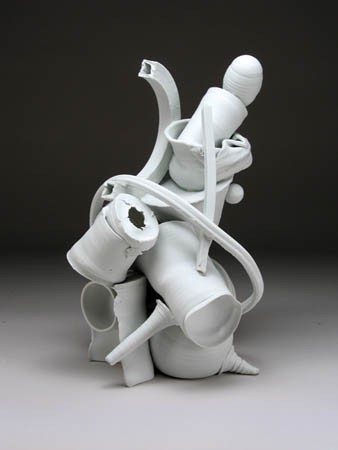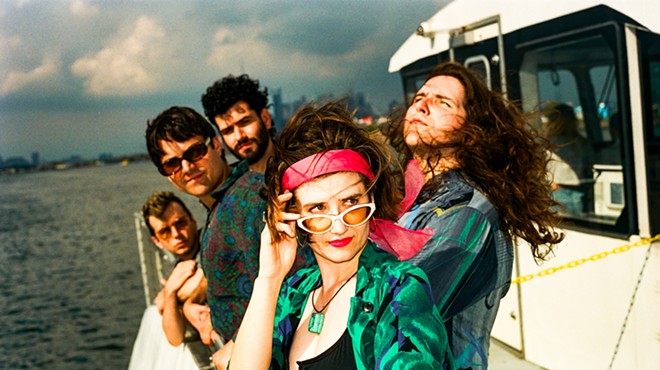Pittsburgh knows all too well the effects of economic downturn. Ghosts of its robust industrial past are all around. Since much of the city's identity is related to industry and labor, curator Dan Byers chose the theme of "work" for his segment of this year's four-part Pittsburgh Biennial. His approach, on display at the Carnegie Museum of Art, broadly interprets "work" as both process and product (as in "work of art"), and "labor" as both action and commodity.
Enter the exhibition from the broad staircase connecting the museum lobby to the art galleries. Here you'll begin with work by Peggy Ahwesh, whose multi-channel video installation "The Ape of Nature" sets the tone for the entire exhibition. The piece uses Pittsburgh's industrial heritage to create a complex and multilayered exploration of place, time, artistic production, nostalgia, malaise and compulsion … all subjects reflected elsewhere in the show.
Incorporated into this installation is footage from inside Swissvale's Kopp Glass factory, as well as industrial cast-offs that were made there. A functioning factory, Kopp exists in Pittsburgh's post-industrial landscape like a symbolic manifestation of its past, but also of its present and future. Early in its history, Kopp developed a "selenium red" glass that was used for railroad signals. This may have influenced Ahwesh's decision to play off Werner Herzog's Heart of Glass, a 1976 film about an 18th-century Bavarian town with a factory that produced a brilliant ruby-red glass. Like Herzog, Ahwesh hypnotized her actors so that they move about her videos like specters.
Other ghosts linger throughout the exhibition. The dreamlike, muted paintings of Fabrizio Gerbino, for instance, reflect the post-industrial landscape in which he lives. But they also hint at themes of death, memory, work, renewal and the process of painting itself. His images and objects hover between reality and dreams. They are at once familiar and enigmatic.
So too are the melancholic drawings and paintings of Frank Santoro. His untitled paintings, like Gerbino's, have parenthetical names like "tunnel" and "calm river from above." They are nostalgic memories and melancholic observations of Pittsburgh in an abbreviated style. "The Glory that was Pittsburgh," a comic strip commissioned for the Biennial, is also filled with tunnels, rivers, trains and bridges. Mostly unpeopled, the cells reveal landscapes of loneliness and loss but also of hope. Santoro narrates: "The city is like Pompeii to me. A ruin that used to be." But also "A Glory that was and will always be."
Also conflating time, place and myth are Jamie Gruzska's photographs. Each piece is titled by the date the image was taken or found, as well as by the date it was printed. These dates are often decades apart. As with the work of Gerbino and Santoro, Gruzska's catalogue of images presents an archive of nostalgia, memory and longing. The process of diligently collecting and later developing in a darkroom is as important as, or perhaps even more important than, the final product.
Byers is clearly interested in this "work" that is both action and outcome, this drive to make art. He has combined the work of three artists into one large gallery, which he calls the "process of making room." Inside are pieces by Ed Eberle, Brandon Boan and Zak Prekop. All three artists explore and push their particular mediums. Eberle's gestural abstractions are made out of porcelain. These sculptures mimic everyday materials jumbled together, but they are studies in space and texture, revealing both the properties of the clay and the artist's manipulation of the material. Prekop's paintings similarly expose his handiwork, by subtly acknowledging the stretcher beneath the canvas or by confusing depth and surface through hidden layers. Layers are also evident in Boan's "well-adjusted wall" and his series of sculptures made from cast-offs found in the ceramics studio. Each of these objects shows the residues and stratifications of its own making.
Lenka Clayton's "Maternity Leave" is a conceptual exploration of the most literal form of labor and creation -- birth and motherhood. For this piece, she has placed an audio baby monitor on a pedestal, allowing visitors to listen to her daily activities at home with her newborn. Like Clayton, Stephanie Beroes presents a more organic and ephemeral type of creation, this time in the form of a burgeoning underground culture. "Debt Begins at Twenty" is a 16mm film from 1980 that evokes Pittsburgh's late-'70s punk scene.
As evidenced by this exhibition, Pittsburgh's culture, history, landscape and mythology are clearly an inspiration -- both to the artists who live here, and to those just passing through.
PITTSBURGH BIENNIAL at the Carnegie Museum of Art continues through Sept. 18. 4400 Forbes Ave., Oakland. 412-622-3131 or www.cmoa.org















